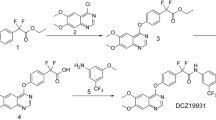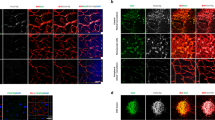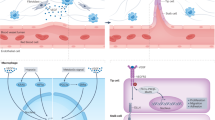Abstract
Purpose
Anti-angiogenesis drug therapy is ineffective in treating uveal melanoma since it only targets angiogenesis leaving vasculogenic mimicry aside. There is no effective clinical strategy targeting vasculogenic mimicry, yet. We show here that CD146 is a novel target to inhibit uveal melanoma progression since it regulates both uveal melanoma angiogenesis and vasculogenic mimicry activity.
Methods
CD146 inhibition was achieved with its specific siRNAs or antibody AA98. Tube formation and migration of primary human retinal microvascular endothelial cells and tube-like structure formation, migration, invasion of uveal melanoma cells were evaluated after CD146 inhibition. The underlying mechanisms were investigated by Western blot and immunofluorescence. Finally, uveal melanoma cells were injected subretinally into the eyes of nude mice and AA98 was administrated. Tumor size was revealed by H&E staining, and angiogenesis and vasculogenic mimicry were evaluated with CD31-PAS staining.
Results
CD146 inhibition induced declines in tube formation and migration of primary human retinal microvascular endothelial cells and tube-like structure formation of uveal melanoma cells. CD146 mediated VEGFR/AKT/p38/NF-κB and FAK/VE-cadherin signal cascades were partially responsible for these biological effects. CD146 blockade by siRNA or AA98 also resulted in inhibition of migration and invasion as well as EMT process of uveal melanoma cells. The physiological relevance of such declines was confirmed by showing that AA98 treatment markedly suppressed the tumor growth, angiogenesis and vasculogenic mimicry induced by implantation of uveal melanoma cells into the eyes of nude mice.
Conclusions
CD146 is a novel mediator of both angiogenesis and vasculogenic mimicry in uveal melanoma. Its antibody AA98 has the potency to be developed as a new antibody drug for treating uveal melanoma. Our results warrant further assessment of CD146 as a potential target to improve therapeutic management of uveal melanoma in a clinical setting.






Similar content being viewed by others
Data availability
All data generated or analyzed during this study are included in this article. The datasets and materials used and/or analyzed during the current study are available from the corresponding author on reasonable request.
Abbreviations
- AKT:
-
Protein kinase B
- ANOVA:
-
Analysis of variance
- CM:
-
Conditioned medium
- DAB:
-
Diaminobenzidine
- DMEM:
-
Dulbecco’s modified Eagle’s medium
- ECM:
-
Endothelial cell medium
- EMT:
-
Epithelial-mesenchymal transition
- FAK:
-
Focal adhesion kinase
- FBS:
-
Fetal bovine serum
- H&E:
-
Hematoxylin and eosin
- HRMEC:
-
Human retinal microvascular endothelial cell
- HRP:
-
Horseradish peroxidase
- MCAM:
-
Melanoma cell adhesion molecule
- MVD:
-
Mean vessel density
- NC:
-
Negative control
- NF-κB:
-
Nuclear factor kappa B
- PAS:
-
Periodic acid Schiff
- VEGF:
-
Vascular endothelial growth factor
- VEGFR:
-
Vascular endothelial growth factor receptor
- VMD:
-
Mean value of vasculogenic mimicry density
References
V.A. White, J.D. Chambers, P.D. Courtright, W.Y. Chang, D.E. Horsman, Correlation of cytogenetic abnormalities with the outcome of patients with uveal melanoma. Cancer 83, 354–359 (1998)
E.S. Rantala, M.M. Hernberg, S. Piperno-Neumann, H.E. Grossniklaus, T.T. Kivela, Metastatic uveal melanoma: The final frontier. Prog. Retin. Eye Res. 101041 (2022) https://doi.org/10.1016/j.preteyeres.2022.101041
C.D.M. Roelofsen, A.P.A. Wierenga, S. van Duinen, R.M. Verdijk, J. Bleeker, M. Marinkovic, G.P.M. Luyten, M.J. Jager, Five decades of enucleations for uveal melanoma in one center: More tumors with high risk factors, no improvement in survival over time. Ocul. Oncol. Pathol. 7, 133–141 (2021). https://doi.org/10.1159/000509918
M. El Filali, P.A. Van der Velden, G.P.M. Luyten, M.J. Jager, Anti-angiogenic therapy in uveal melanoma. Dev. Ophthalmol. 49, 117–136 (2012). https://doi.org/10.1159/000329591
F. Castet, S. Garcia-Mulero, R. Sanz-Pamplona, A. Cuellar, O. Casanovas, J.M. Caminal, J.M. Piulats, Uveal melanoma, angiogenesis and immunotherapy, Is there any hope? Cancers (Basel) 11, (2019) https://doi.org/10.3390/cancers11060834
I.C. Notting, G.S. Missotten, B. Sijmons, Z.F. Boonman, J.E. Keunen, G. van der Pluijm, Angiogenic profile of uveal melanoma. Curr. Eye Res. 31, 775–785 (2006). https://doi.org/10.1080/02713680600865052
S. Piperno-Neumann, A. Diallo, M.C. Etienne-Grimaldi, F.C. Bidard, M. Rodrigues, C. Plancher, P. Mariani, N. Cassoux, D. Decaudin, B. Asselain, V. Servois, Phase II trial of bevacizumab in combination with temozolomide as first-line treatment in patients with metastatic uveal melanoma. Oncologist 21, 281–282 (2016). https://doi.org/10.1634/theoncologist.2015-0501
A.A. Tarhini, P. Frankel, K.A. Margolin, S. Christensen, C. Ruel, J. Shipe-Spotloe, D.R. Gandara, A. Chen, J.M. Kirkwood, Aflibercept (VEGF Trap) in inoperable stage III or stage iv melanoma of cutaneous or uveal origin. Clin. Cancer Res. 17, 6574–6581 (2011). https://doi.org/10.1158/1078-0432.CCR-11-1463
J.C. Moser, J.S. Pulido, R.S. Dronca, R.R. McWilliams, S.N. Markovic, A.S. Mansfield, The Mayo Clinic experience with the use of kinase inhibitors, ipilimumab, bevacizumab, and local therapies in the treatment of metastatic uveal melanoma. Melanoma Res. 25, 59–63 (2015). https://doi.org/10.1097/CMR.0000000000000125
J.H. Francis, J. Kim, A. Lin, R. Folberg, S. Iyer, D.H. Abramson, Growth of uveal melanoma following intravitreal bevacizumab. Ocul. Oncol. Pathol. 3, 117–121 (2017). https://doi.org/10.1159/000450859
A.J. Maniotis, R. Folberg, A. Hess, E.A. Seftor, L.M. Gardner, J. Pe’er, J.M. Trent, P.S. Meltzer, M.J. Hendrix, Vascular channel formation by human melanoma cells in vivo and in vitro: vasculogenic mimicry. Am. J. Pathol. 155, 739–752 (1999). https://doi.org/10.1016/S0002-9440(10)65173-5
S.L. Wechman, L. Emdad, D. Sarkar, S.K. Das, P.B. Fisher, Vascular mimicry: Triggers, molecular interactions and in vivo models. Adv. Cancer Res. 148, 27–67 (2020). https://doi.org/10.1016/bs.acr.2020.06.001
A. Joshkon, X. Heim, C. Dubrou, R. Bachelier, W. Traboulsi, J. Stalin, H. Fayyad-Kazan, B. Badran, A. Foucault-Bertaud, A.S. Leroyer, N. Bardin, M. Blot-Chabaud, Role of CD146 (MCAM) in physiological and pathological angiogenesis-contribution of new antibodies for therapy. Biomedicines 8, 633 (2020). https://doi.org/10.3390/biomedicines8120633
T. Jiang, J. Zhuang, H. Duan, Y. Luo, Q. Zeng, K. Fan, H. Yan, D. Lu, Z. Ye, J. Hao, J. Feng, D. Yang, X. Yan, CD146 is a coreceptor for VEGFR-2 in tumor angiogenesis. Blood 120, 2330–2339 (2012). https://doi.org/10.1182/blood-2012-01-406108
X. Yan, Y. Lin, D. Yang, Y. Shen, M. Yuan, Z. Zhang, P. Li, H. Xia, L. Li, D. Luo, Q. Liu, K. Mann, B.L. Bader, A novel anti-CD146 monoclonal antibody, AA98, inhibits angiogenesis and tumor growth. Blood 102, 184–191 (2003). https://doi.org/10.1182/blood-2002-04-1004
P. Bu, L. Gao, J. Zhuang, J. Feng, D. Yang, X. Yan, Anti-CD146 monoclonal antibody AA98 inhibits angiogenesis via suppression of nuclear factor-kappaB activation. Mol. Cancer Ther. 5, 2872–2878 (2006). https://doi.org/10.1158/1535-7163.MCT-06-0260
R. Crepin, D. Gentien, A. Duche, A. Rapinat, C. Reyes, F. Nemati, G. Massonnet, D. Decaudin, S. Djender, S. Moutel, K. Desrumeaux, N. Cassoux, S. Piperno-Neumann, S. Amigorena, F. Perez, S. Roman-Roman, A. de Marco, Nanobodies against surface biomarkers enable the analysis of tumor genetic heterogeneity in uveal melanoma patient-derived xenografts. Pigment Cell Melanoma Res. 30, 317–327 (2017). https://doi.org/10.1111/pcmr.12577
K. Lai, V. Sharma, M.J. Jager, R.M. Conway, M.C. Madigan, Expression and distribution of MUC18 in human uveal melanoma. Virchows Archiv. 451, 967–976 (2007). https://doi.org/10.1007/s00428-007-0498-0
Y. Krishna, A. Acha-Sagredo, D. Sabat-Pospiech, N. Kipling, K. Clarke, C.R. Figueiredo, H. Kalirai, S.E. Coupland, Transcriptome profiling reveals new insights into the immune microenvironment and upregulation of novel biomarkers in metastatic uveal melanoma. Cancers (Basel) 12, 2832 (2020). https://doi.org/10.3390/cancers12102832
D.N. Hu, S.A. McCormick, R. Ritch, K. Pelton-Henrion, Studies of human uveal melanocytes in vitro: isolation, purification and cultivation of human uveal melanocytes. Invest. Ophthalmol. Vis. Sci. 34, 2210–2219 (1993)
Y. Zhang, C. Zheng, J. Zhang, D. Yang, J. Feng, D. Lu, X. Yan, Generation and characterization of a panel of monoclonal antibodies against distinct epitopes of human CD146. Hybridoma (Larchmt) 27, 345–352 (2008). https://doi.org/10.1089/hyb.2008.0034
M. Pardo, A. Garcia, B. Thomas, A. Pineiro, A. Akoulitchev, R.A. Dwek, N. Zitzmann, The characterization of the invasion phenotype of uveal melanoma tumour cells shows the presence of MUC18 and HMG-1 metastasis markers and leads to the identification of DJ-1 as a potential serum biomarker. Int. J. Cancer 119, 1014–1022 (2006). https://doi.org/10.1002/ijc.21942
M. el Filali, G.S. Missotten, W. Maat, L.V. Ly, G.P. Luyten, P.A. van der Velden, M.J. Jager, Regulation of VEGF-A in uveal melanoma. Invest. Ophthalmol. Vis. Sci. 51, 2329–2337 (2010). https://doi.org/10.1167/iovs.09-4739
C. Zheng, Y. Qiu, Q. Zeng, Y. Zhang, D. Lu, D. Yang, J. Feng, X. Yan, Endothelial CD146 is required for in vitro tumor-induced angiogenesis: the role of a disulfide bond in signaling and dimerization. Int. J. Biochem. Cell Biol. 41, 2163–2172 (2009). https://doi.org/10.1016/j.biocel.2009.03.014
J. Zhuang, T. Jiang, D. Lu, Y. Luo, C. Zheng, J. Feng, D. Yang, C. Chen, X. Yan, NADPH oxidase 4 mediates reactive oxygen species induction of CD146 dimerization in VEGF signal transduction. Free Radic. Biol. Med. 49, 227–236 (2010). https://doi.org/10.1016/j.freeradbiomed.2010.04.007
D. Delgado-Bellido, M. Fernandez-Cortes, M.I. Rodriguez, S. Serrano-Saenz, A. Carracedo, A. Garcia-Diaz, F.J. Oliver, VE-cadherin promotes vasculogenic mimicry by modulating kaiso-dependent gene expression. Cell Death Differ. 26, 348–361 (2019). https://doi.org/10.1038/s41418-018-0125-4
A. Tura, V.E. Pawlik, M. Rudolf, J.S. Ernesti, J.N. Stutzer, S. Grisanti, M. Ranjbar, Uptake of ranibizumab but not bevacizumab into uveal melanoma cells correlates with a sustained decline in VEGF-A levels and metastatic activities. Cancers (Basel) 11, 868 (2019). https://doi.org/10.3390/cancers11060868
C.I. Schnegg, M.H. Yang, S.K. Ghosh, M.Y. Hsu, Induction of vasculogenic mimicry overrides VEGF-A silencing and enriches stem-like cancer cells in melanoma. Cancer Res 75, 1682–1690 (2015). https://doi.org/10.1158/0008-5472.CAN-14-1855
L. Chen, S. Zhang, X. Li, B. Sun, X. Zhao, D. Zhang, S. Zhao, A pilot study of vasculogenic mimicry immunohistochemical expression in intraocular melanoma model. Oncol. Rep. 21, 989–994 (2009). https://doi.org/10.3892/or_00000313
D. Delgado-Bellido, S. Serrano-Saenz, M. Fernandez-Cortes, F.J. Oliver, Vasculogenic mimicry signaling revisited: focus on non-vascular VE-cadherin. Mol Cancer 16, 65 (2017). https://doi.org/10.1186/s12943-017-0631-x
Z. Wang, Q. Xu, N. Zhang, X. Du, G. Xu, X. Yan, CD146, from a melanoma cell adhesion molecule to a signaling receptor. Signal Transduct. Target. Ther. 5, 148 (2020). https://doi.org/10.1038/s41392-020-00259-8
B. Xue, P. Wang, W. Yu, J. Feng, J. Li, R. Zhao, Z. Yang, X. Yan, H. Duan, CD146 as a promising therapeutic target for retinal and choroidal neovascularization diseases. Sci. China Life Sci. (2021). https://doi.org/10.1007/s11427-021-2020-0
Q. Zeng, W. Li, D. Lu, Z. Wu, H. Duan, Y. Luo, J. Feng, D. Yang, L. Fu, X. Yan, CD146, an epithelial-mesenchymal transition inducer, is associated with triple-negative breast cancer. Proc. Natl. Acad. Sci. U. S. A. 109, 1127–1132 (2012). https://doi.org/10.1073/pnas.1111053108
H. Yang, M.J. Jager, H.E. Grossniklaus, Bevacizumab suppression of establishment of micrometastases in experimental ocular melanoma. Invest. Ophthalmol. Vis. Sci. 51, 2835–2842 (2010). https://doi.org/10.1167/iovs.09-4755
J.M. Lehmann, B. Holzmann, E.W. Breitbart, P. Schmiegelow, G. Riethmuller, J.P. Johnson, Discrimination between benign and malignant cells of melanocytic lineage by two novel antigens, a glycoprotein with a molecular weight of 113,000 and a protein with a molecular weight of 76,000. Cancer Res. 47, 841–845 (1987)
R.K. Jain, Antiangiogenesis strategies revisited: from starving tumors to alleviating hypoxia. Cancer Cell 26, 605–622 (2014). https://doi.org/10.1016/j.ccell.2014.10.006
C. Masaoutis, S. Kokkali, S. Theocharis, Immunotherapy in uveal melanoma: novel strategies and opportunities for personalized treatment. Expert Opin Investig. Drugs, 1–15 (2021). https://doi.org/10.1080/13543784.2021.1898587
P. Nathan, J.C. Hassel, P. Rutkowski, J.F. Baurain, M.O. Butler, M. Schlaak, R.J. Sullivan, S. Ochsenreither, R. Dummer, J.M. Kirkwood, A.M. Joshua, J.J. Sacco, A.N. Shoushtari, M. Orloff, J.M. Piulats, M. Milhem, A.K.S. Salama, B. Curti, L. Demidov, L. Gastaud, C. Mauch, M. Yushak, R.D. Carvajal, O. Hamid, S.E. Abdullah, C. Holland, H. Goodall, S. Piperno-Neumann, I.M.-. Investigators, Overall Survival Benefit with Tebentafusp in Metastatic Uveal Melanoma. N. Engl. J. Med. 385, 1196–1206 (2021). https://doi.org/10.1056/NEJMoa2103485
Acknowledgements
Not applicable.
Funding
This work was supported by Zhejiang Provincial Natural Science Foundation of China (LY21H120006, LY16H120009), the Project of State Key Laboratory of Ophthalmology, Optometry and Visual Science, Wenzhou Medical University (J02-20190201), and the Youth Innovation Promotion Association of Chinese Academy of Sciences (2018122).
Author information
Authors and Affiliations
Contributions
QH, JQ, and HD conceived and designed this project. RZ, XC, SC, JT, FC and YL performed experiments. RZ, PR, XY, LT, HD, JQ and QH analyzed the data and drafted the manuscript. All authors reviewed and edited the final manuscript version. All authors read and approved the final manuscript.
Corresponding authors
Ethics declarations
Ethics approval
All studies and procedures involving human tissues were approved by the Wenzhou Medical University ethics committee and performed in compliance with the Declaration of Helsinki and national laws. Studies on animals were performed in compliance with the ARVO Statement for the use of animals in Ophthalmic and Visual Research and with the Institutional Animal Care and Use Committee policies and procedures of Wenzhou Medical University.
Consent for publish
Not applicable.
Competing interests
The authors declare that they have no competing interests.
Additional information
Publisher's note
Springer Nature remains neutral with regard to jurisdictional claims in published maps and institutional affiliations.
Rights and permissions
About this article
Cite this article
Zhang, R., Chen, X., Chen, S. et al. Inhibition of CD146 lessens uveal melanoma progression through reducing angiogenesis and vasculogenic mimicry. Cell Oncol. 45, 557–572 (2022). https://doi.org/10.1007/s13402-022-00682-9
Accepted:
Published:
Issue Date:
DOI: https://doi.org/10.1007/s13402-022-00682-9




